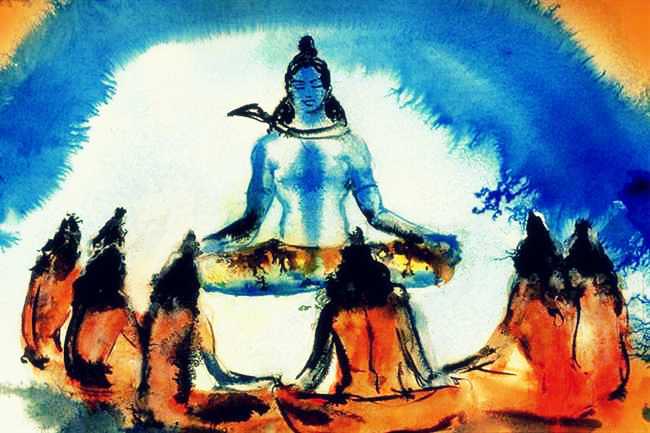
Guru Purnima is a day of veneration and glorification of one’s Guru. This is the day to express thankfulness and gratitude to the ones who teach us, guide us and mould our lives. Guru Purnima is an affirmation of the ancient Guru-Shishya tradition. This celestial festival holds great significance in Hinduism, Sikhism, Buddhism, and Jainism. Guru Purnima is celebrated as a festival all over India on the Full Moon Day (Purnima) in the Hindu month of Ashadha (June-July).
This year Guru Purnima tithi will begin
at 01:36 AM on July 10, 2025 and end at
02:06 AM on July 11, 2025.
Who is a ‘Guru’?
Guru is loosely translated as a ‘Teacher’. But the meaning and significance of Guru goes beyond just that. According to Ved Vyas’s ‘Guru Gita’, GU means ‘Attributeless’ and RU means ‘Formless’. Thus, a Guru is the one who bestows upon you the knowledge which helps you to transcend all the material obstacles and know the Ultimate – the Attribute less and the Formless. In simplified form, GU means Darkness of Ignorance and RU means Remover. So a Guru is the one who helps you banish the darkness of your ignorance and leads you to the Ultimate Knowledge, to Self-realization. The importance of a Guru has been beautifully expounded in these lines by Sant Kabir:

Meaning: “I stand before both God and my Guru. Whom should I bow to first? I first bow to my Guru because He is the one who showed me the path to God.”
Above all, we should not forget to express our gratitude and thankfulness to our FIRST GURU – our MOTHERS!
Significance of Guru Purnima
We can trace the significance of Guru Purnima back to ancient times when the revered sage Vyasa, author of the Mahabharata, was born. Veda Vyasa not only wrote the epic but also compiled the four Vedas, making him a symbol of divine wisdom and knowledge. On this day, disciples pay homage to their gurus and express gratitude for their teachings, guidance, and enlightenment.
Guru Purnima is not limited to spiritual gurus alone; it also extends to academic mentors, teachers, and parents who have imparted wisdom and knowledge. It is an opportunity to reflect on the invaluable contributions of these mentors in shaping our lives and society as a whole.
In the ancient days, the sages used to travel from one place to another constantly. However, in the four months beginning from Ashadha, they had to settle down temporarily in certain places due to the monsoons. These transitory camps would become a central place where disciples would gather to gain knowledge from the wise and learned sages. No wonder, Guru Purnima marks the auspicious beginning of the holy months of ‘Chaturmaas’ – a period of four months of learning, penance and meditation.
Why do we celebrate Guru Purnima?

There are many stories and legends explaining the origin of Guru Purnima. One of them is related to Shiva and the Sapta Rishis (the Seven Sages). Shiva is the first Yogi – Adi Yogi – the originator of Yoga. The Sapta Rishis underwent penance and meditated for 84 years; waiting patiently for Shiva to come out of his Yogic trance and impart the divine and mystical knowledge of Yoga to them. Shiva ultimately opened his eyes on the Full Moon night of the Ashadha month and it was on this night itself that he transmitted His knowledge to these seven sages. Thus the Sapta Rishis became the intermediaries – the first Gurus – to pass on the so-obtained Divine knowledge to the mortal human beings; and thus Shiva became the First Divine Guru or Teacher.

Guru Purnima is also largely celebrated as ‘Vyasa Purnima’ – in commemoration of the great Sage Veda Vyasa. He is so-called because he is the compiler and editor of the four VEDAS. Besides this, he is the author of the 18 Puranas, the Brahmasutras, the Guru Gita, the Mahabharata and the Srimad Bhagavata. He is also the Guru of Lord Dattatreya, who is the ‘Guru of all Gurus’. Many consider Guru Purnima to be the day when Ved Vyasa started writing the Brahma Sutras.
The Buddhists believe that Lord Buddha gave his first sermon at Sarnath, India on this very day. Hence Guru Purnima is a great day of celebration for them too. The Sikhs revere their ten Gurus – who are the foundation of Sikhism. Hence Guru Purnima is a significant day for them. Guru Purnima is celebrated with great pomp at Sai Baba Temple at Shirdi.
ASTROLOGICAL SIGNIFICANCE OF GURU PURNIMA:
Astrologically, the full Moon on Guru Purnima holds special significance. The moon, representing the mind and emotions, is at its peak radiance on this day. The energy of the Moon enhances receptivity, intuition and the ability to absorb knowledge. This makes Guru Purnima an ideal time to connect with higher realms, seek spiritual guidance, and deepen our understanding of divine wisdom.
Additionally, the planet Jupiter – Brihaspati or Guru – represents knowledge, wisdom, and spiritual growth. On Guru Purnima, Moon transits in Sagittarius sign – the sign of Jupiter while Sun is in Gemini – the sign of Mercury. Now Mercury represents an agile, inquisitive, restless mind; eager to gain knowledge. Mercury is also a sign of speech and communication. On the other hand, Jupiter represents Higher Knowledge, Rationality, spirituality and a deep understanding of complex matters. Jupiter also signifies expansion and concentration. Now Moon represents the Mind and Emotions while Sun represents the Soul.
Thus Sun in Gemini and Moon in Sagittarius is the ultimate combination of heightened observation, sensitivity and creativity. Sun in restless Gemini probes for answers to deep and complex questions while the Full Moon in the wise and expansive sign of Sagittarius is ready to receive the nectar of Knowledge. It is also a rare combination of logic (Mercury) and faith (Jupiter). Even otherwise, the Sanskrit name of Mercury is Budha meaning Intelligence while Jupiter is called GURU – the wise Teacher. What a blend!
Remedies and Rituals for Guru Purnima
Thus Guru Purnima is a great day for doing remedies if one has afflicted Guru (Jupiter) in his birth chart or is having Guru Chandal Yog or Pitru Dosha or is running through Guru Mahadasha or Antardasha. The remedies include:
- Guru Puja: Perform a puja (ritual worship) dedicated to your spiritual or academic mentor. Set up a sacred space with their photograph or an idol, light a diya and incense, offer yellow flowers, and chant mantras or prayers. Express your gratitude and seek their blessings.
- Guru Dakshina: Guru Dakshina is a traditional practice of offering gratitude to your guru by giving a monetary donation or a gift. On Guru Purnima, express your gratitude by offering a token of appreciation or a donation to your spiritual mentor or a deserving teacher who has influenced your life positively.
- Mantra Chanting: Recite the Jupiter mantra to invoke the blessings of this benefic planet. The mantra associated with Jupiter is “Om Graam Greem Groum Sah Guruve Namah.” Chant this mantra 108 times on Guru Purnima to enhance your spiritual growth and receive divine guidance. The Gayatri Mantra and the Maha Mrityunjaya Mantra, too, are powerful chants that invoke divine guidance and wisdom.
- Meditation and Reflection: Set aside time for deep meditation and introspection. Connect with your inner self, express gratitude for the knowledge received, and seek clarity on your spiritual path. Reflect on how you can apply the teachings in your daily life.
- Charity and Seva: Engage in acts of kindness and service to others. Offer assistance or support to those in need. Donating books, educational materials, or supporting educational initiatives are particularly meaningful on this day. Donate yellow lentils (chana dal) to a Brahmin or a person in need. You can also donate bananas to the aged, orphans and needy people.
- Fasting: Observing a fast on Guru Purnima is a powerful way to purify your mind and body while focusing on spiritual pursuits. You can choose to fast from sunrise to sunset or opt for a partial fast by consuming only light meals or fruits during the day. Fasting helps to develop self-discipline and fosters a deeper connection with your spiritual practices.
- Rudraksha or Yellow Sapphire: Wearing a Rudraksha bead or a yellow sapphire (Pukhraj) gemstone can enhance the positive influence of Jupiter in your life. Rudraksha beads are known for their spiritual significance, while yellow sapphire is believed to strengthen wisdom, knowledge, and intuition.
- Study and Learning: Dedicate some time to study, read spiritual texts, or engage in intellectual pursuits.
Traditional offerings made to a Guru include flowers, fruits (preferably yellow coloured – in ancient days, lime was a must), a piece of unstitched cloth, some Dakshina (payment in money or gold/silver) wrapped in a paan (betel leaf).
Those who are facing a delay in getting married can also do the following remedies on Guru Purnima:
- Donate yellow-coloured fruits, sweatmeats (Besan Laddoo) and clothes to the needy and Brahmans.
- Offer water to the roots and worship the Banyan tree or Peepal tree or Mango Tree.
- Apply saffron tilak and pray to Guru to remove all the hurdles in getting the marriage fixed.
Some Mantras for Guru:
Bija Mantra:
|| Om graam greem graum sah brihaspataye namah || or || Om brim brihaspataye namah ||
Guru Mantra:
|| Guru Brahma, Guru Vishnu, Guru devo Maheshwara, Guru sakshat, param Brahma, tasmai Shri Guravay namah ||
Pauranik Mantra:
|| Om Guruve namah ||
Vyasa Mantra:
|| Vyasa mantra – Vyam Vyaasadevaaya Namah ||


